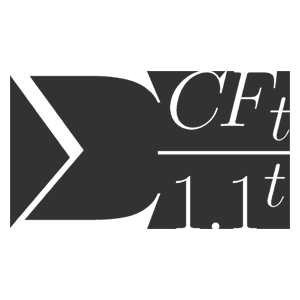Our first logo is the mathematical formula for calculating the Net Present Value of Cash Flows (CF), using a discount rate of 10%, or as often called in industry, “npv10.”
The symbol Σ means to sum all the values in the series represented on the right. Although I don’t include the bounds, they are often assumed to be from time period zero (initial investment) through some future time period. CFt thus representing the cash flows for time period t.
The divisor is 1.1t, while the general formula should be divided by (1+i)t. As I named the company npv10, I just assumed the interest rate i was 10% or 0.1. For time period zero the divisor is 1.10 (equals 1), for time period 1 it is 1.11 (equals 1.1), and so forth.
But why the NPV of Cash Flows? Why not NPV of Net Income or Revenues or EBITDA, or use IRR (Internal Rate of Return)?
The NPV of Cash Flows has been found to be a good way to compare projects to one another, and take into account the timing of the cash flows to the company. Earning money back sooner is more valuable to earning the same amount later.
But the software does not compare projects against one another according to their individual NPV. A number of successful companies do that, but they’re missing out on a number of important points:
- Projects do not exist in isolation. They compete for limited resources with other opportunities, so they are all interrelated even if not obviously so. (See the example I did for a technology company.)
- Projects may directly depend on other projects. For example, an oil company may drill a test well, and the result of that test may determine how many other producing wells they drill in the area. The test well is not expected to produce any return, so it has a negative NPV. But if the test is positive, each of the production wells can move forward, producing positive returns. Our software enables you to directly connect one or more projects, so selecting one or more producing wells (with positive NPV) requires that the associated test well (with negative NPV) is also selected.
- Timing matters. If you are attempting to manage the company, and it selects nothing but projects with large NPVs, where the positive cash flows are in the distant future, you will need cash to sustain you until those start returning cash. This is why I often recommend setting minimum goals for Cash balances, to ensure the company survives any periods of low cash flow. In this way, the software may select projects with smaller NPVs first, because they may return cash sooner, and that can be put back into funding the larger projects later.
The final point I wish to make is that while I named the company after a useful calculation, the software allows you to set goals and constraints on almost any of your metrics and KPIs, and decide which one you wish to maximize or minimize for each analysis. You may wish to maximize Revenue, Production, or Revenue, or minimize Capital Expenditures, or Marketing Expenses, to see how you can best achieve your strategy.
As your company figures out which goals, constraints, and optimized metrics most matter, you will get the most value for your company, and help it develop its strategy and plan for the future.

